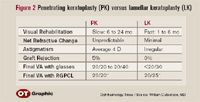Article
Lamellar or PK may be last resort for ectasia after LASIK
Miami-When other possible treatments for ectasia fail, lamellar or penetrating keratoplasty (PK) may be the last resort for these patients.

"Indications for this treatment are the inability to see adequately with glasses or rigid gas-permeable contact lenses and when other means of correction fail, including collagen cross-linking," said William Culbertson, MD, professor of ophthalmology and director of the Bascom Palmer Laser Vision Center, Bascom Palmer Eye Institute, Miami. "The goal is to make the patient visually functional again with either glasses or contact lenses."

In patients who require keratoplasty, the routine preoperative evaluation includes documentation of the patient's vocation and avocation and determination of the patient's expectations and the ability to wear a contact lens postoperatively. In addition, the cause of the ectasia-for example, too-thin bed or an inherent weakness in the corneal tissue-and the corneal thickness profile should be determined if possible, according to Dr. Culbertson.
Corneal steepening examined

"Is the area of steepening central with central apical elevation and central thinning, or is it inferior, for example, with corresponding inferior thinning?" Dr. Culbertson posed. "We can also use OCT to look at the residual stromal bed to determine if it is thin or if the cornea is just distorting with a normal-thickness bed. These factors are important for determining which keratoplasty technique to use."
PK can be performed using a manual trephine, but this may result in cutting through the LASIK flap. The femtosecond laser-shaped keratoplasty can be used with a tongue-and-groove edge, which might enhance healing. Lamellar keratoplasty with an anterior lamellar keratoplasty can be done either manually, with a microkeratome, or with a femtosecond laser that creates a more vertical edge and more strength in the grafted cornea. Finally, deep anterior lamellar keratoplasty (DALK), which spares the corneal endothelium, can be done, Dr. Culbertson explained.
Newsletter
Don’t miss out—get Ophthalmology Times updates on the latest clinical advancements and expert interviews, straight to your inbox.




